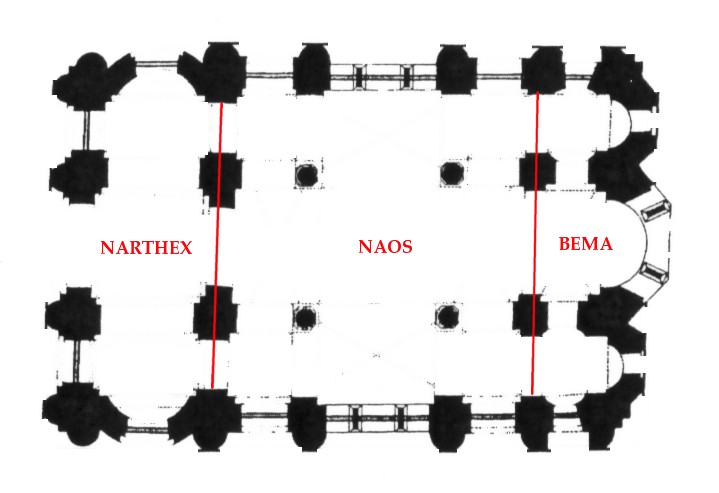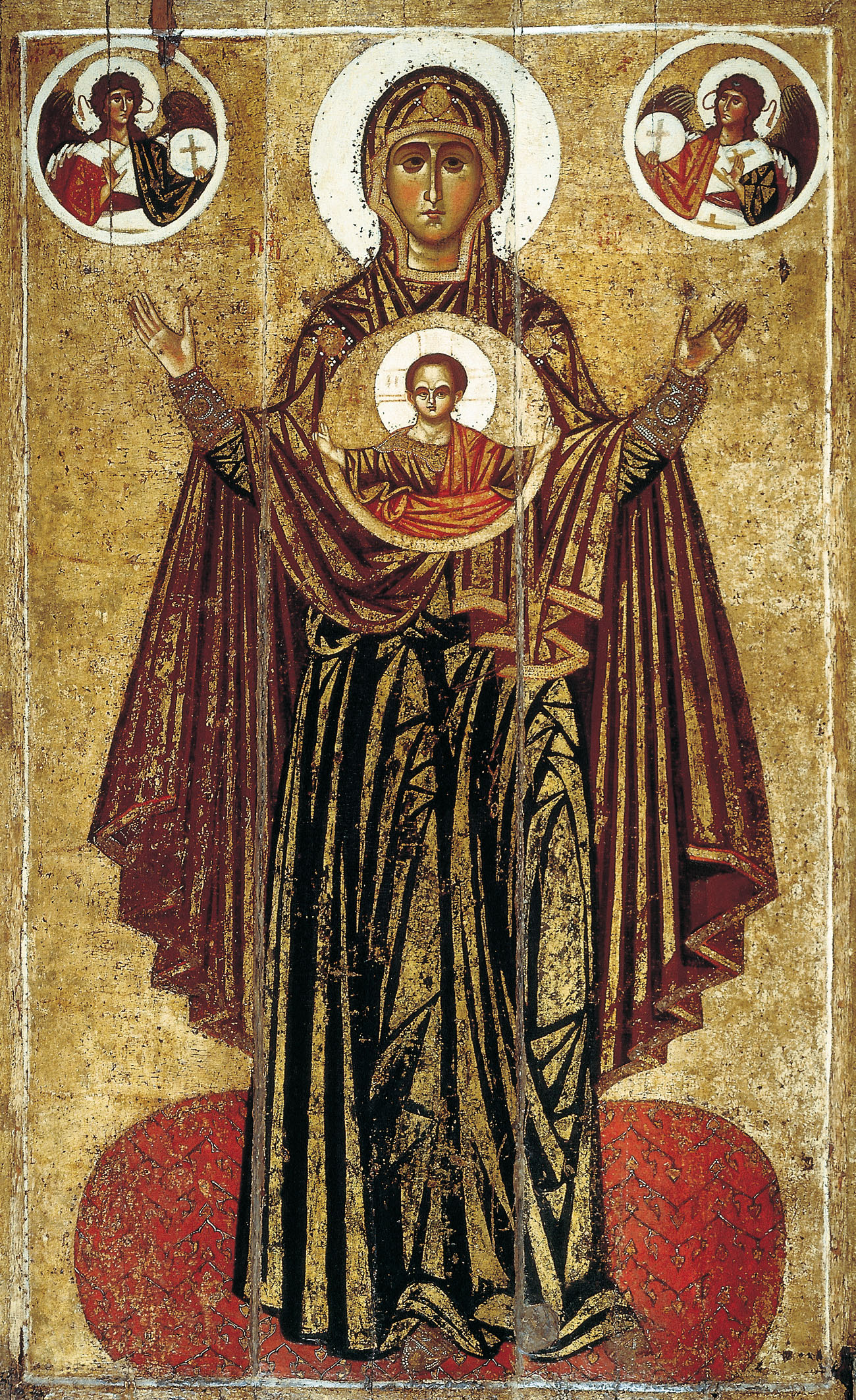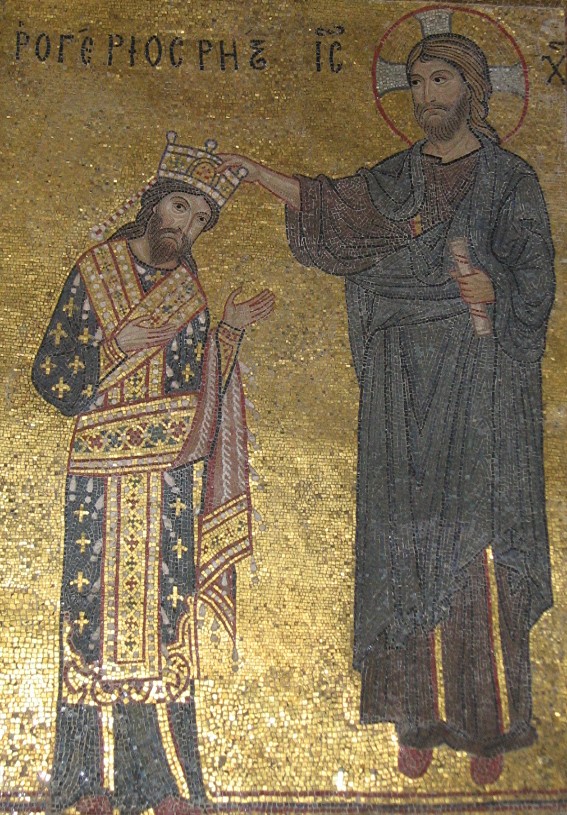|
Cross-in-square
A cross-in-square or crossed-dome plan was the dominant architectural form of middle- and late-period Byzantine churches. It featured a square centre with an internal structure shaped like a cross, topped by a dome. The first cross-in-square churches were probably built in the late 8th century, and the form has remained in use throughout the Orthodox world unto the present day. In the West, Donato Bramante's first design (1506) for St. Peter's Basilica was a centrally planned cross-in-square under a dome and four subsidiary domes. In German, such a church is a , or ‘cross-dome church’. In French, it is an , ‘church with an inscribed cross’. Architecture Architectural form A cross-in-square church is centered around a quadratic naos (the ‘square’) which is divided by four columns or piers into nine bays (divisions of space). The inner five divisions form the shape of a quincunx (the ‘cross’). The central bay is usually larger than the other eight, and ... [...More Info...] [...Related Items...] OR: [Wikipedia] [Google] [Baidu] |
Chora Church
'' '' tr, Kariye Mosque'' , image = Chora Church Constantinople 2007 panorama 002.jpg , caption = Exterior rear view , map_type = Istanbul Fatih , map_size = 220px , map_caption = Location within the Fatih district of Istanbul , location = Istanbul, Turkey , coordinates = , latitude = , longitude = , religious_affiliation = Greek Orthodox Church (before 1500),Sunni Islam (1500–1945, 2020–present), Directorate of Religious Affairs of Turkey (1924–1945, 2020–present) , status = , functional_status = Mosque , heritage_designation = , leadership = , website = , architecture = yes , architect = , architecture_type = Church , architecture_style = Byzantine architecture, Greek architecture, Ottoman architecture, Islamic , capacity = , length ... [...More Info...] [...Related Items...] OR: [Wikipedia] [Google] [Baidu] |
Bodrum Mosque
Bodrum Mosque ( tr, Bodrum Camii, or ''Mesih Paşa Camii'' named after its converter) in Istanbul, Turkey, is a former Eastern Orthodox church converted into a mosque by the Ottomans. The church was known under the Greek name of Myrelaion ( el, Eκκλησία του Μυρελαίου). Location The beautiful Byzantine structure is today rather incongruously choked on three sides by modern apartment blocks. It stands in Istanbul, in the district of Fatih, in the neighbourhood of Laleli, one kilometre west of the ruins of the Great Palace of Constantinople. History Some years before 922, possibly during the wars against Simeon I's Bulgaria, the ''drungarius'' Romanos Lekapenos bought a house in the ninth region of Constantinople, not far from the Sea of Marmara, in the place called ''Myrelaion'' ("the place of myrrh" in Greek). After his accession to the throne this building became the nucleus of a new imperial palace, intended to challenge the neighbouring Great Palace of Cons ... [...More Info...] [...Related Items...] OR: [Wikipedia] [Google] [Baidu] |
Dome
A dome () is an architectural element similar to the hollow upper half of a sphere. There is significant overlap with the term cupola, which may also refer to a dome or a structure on top of a dome. The precise definition of a dome has been a matter of controversy and there are a wide variety of forms and specialized terms to describe them. A dome can rest directly upon a rotunda wall, a drum, or a system of squinches or pendentives used to accommodate the transition in shape from a rectangular or square space to the round or polygonal base of the dome. The dome's apex may be closed or may be open in the form of an oculus, which may itself be covered with a roof lantern and cupola. Domes have a long architectural lineage that extends back into prehistory. Domes were built in ancient Mesopotamia, and they have been found in Persian, Hellenistic, Roman, and Chinese architecture in the ancient world, as well as among a number of indigenous building traditions throughout ... [...More Info...] [...Related Items...] OR: [Wikipedia] [Google] [Baidu] |
Cross-in-square
A cross-in-square or crossed-dome plan was the dominant architectural form of middle- and late-period Byzantine churches. It featured a square centre with an internal structure shaped like a cross, topped by a dome. The first cross-in-square churches were probably built in the late 8th century, and the form has remained in use throughout the Orthodox world unto the present day. In the West, Donato Bramante's first design (1506) for St. Peter's Basilica was a centrally planned cross-in-square under a dome and four subsidiary domes. In German, such a church is a , or ‘cross-dome church’. In French, it is an , ‘church with an inscribed cross’. Architecture Architectural form A cross-in-square church is centered around a quadratic naos (the ‘square’) which is divided by four columns or piers into nine bays (divisions of space). The inner five divisions form the shape of a quincunx (the ‘cross’). The central bay is usually larger than the other eight, and ... [...More Info...] [...Related Items...] OR: [Wikipedia] [Google] [Baidu] |
Panagia Chalkeon 2
Panagia ( el, Παναγία, fem. of , + , the ''All-Holy'', or the ''Most Holy''; pronounced ) (also transliterated Panaghia or Panajia), in Medieval and Modern Greek, is one of the titles of Mary, mother of Jesus, used especially in Eastern Catholicism and Orthodox Christianity. Most Greek churches dedicated to the Virgin Mary are called ''Panagia''; the standard western Christian designation of "St. Mary" is rarely used in the Orthodox East, as Mary is considered the holiest of all created beings and therefore of higher status than the Saints. Iconography ''Panagia'' is also the term for a particular type of icon of the Theotokos, wherein she is facing the viewer directly, usually depicted full length with her hands in the '' orans'' position, and with a medallion showing the image of Christ as a child in front of her chest. This medallion symbolically represents Jesus within the womb of the Virgin Mary at the moment of the Incarnation. This type of icon is also called ... [...More Info...] [...Related Items...] OR: [Wikipedia] [Google] [Baidu] |
Apse
In architecture, an apse (plural apses; from Latin 'arch, vault' from Ancient Greek 'arch'; sometimes written apsis, plural apsides) is a semicircular recess covered with a hemispherical vault or semi-dome, also known as an '' exedra''. In Byzantine, Romanesque, and Gothic Christian church (including cathedral and abbey) architecture, the term is applied to a semi-circular or polygonal termination of the main building at the liturgical east end (where the altar is), regardless of the shape of the roof, which may be flat, sloping, domed, or hemispherical. Smaller apses are found elsewhere, especially in shrines. Definition An apse is a semicircular recess, often covered with a hemispherical vault. Commonly, the apse of a church, cathedral or basilica is the semicircular or polygonal termination to the choir or sanctuary, or sometimes at the end of an aisle. Smaller apses are sometimes built in other parts of the church, especially for reliquaries or shrines of ... [...More Info...] [...Related Items...] OR: [Wikipedia] [Google] [Baidu] |
Parekklesion
Parecclesion or parakklesion ( el, παρεκκλήσιον 'chapel') is a type of side chapel found in Byzantine architecture. Examples of existing parecclesions: * Chora Church '' '' tr, Kariye Mosque'' , image = Chora Church Constantinople 2007 panorama 002.jpg , caption = Exterior rear view , map_type = Istanbul Fatih , map_size = 220px , map_caption ... * Pammakaristos Church Chapels Byzantine sacred architecture {{room-stub ... [...More Info...] [...Related Items...] OR: [Wikipedia] [Google] [Baidu] |
Constantinople
la, Constantinopolis ota, قسطنطينيه , alternate_name = Byzantion (earlier Greek name), Nova Roma ("New Rome"), Miklagard/Miklagarth ( Old Norse), Tsargrad ( Slavic), Qustantiniya (Arabic), Basileuousa ("Queen of Cities"), Megalopolis ("the Great City"), Πόλις ("the City"), Kostantiniyye or Konstantinopolis (Turkish) , image = Byzantine Constantinople-en.png , alt = , caption = Map of Constantinople in the Byzantine period, corresponding to the modern-day Fatih district of Istanbul , map_type = Istanbul#Turkey Marmara#Turkey , map_alt = A map of Byzantine Istanbul. , map_size = 275 , map_caption = Constantinople was founded on the former site of the Greek colony of Byzantion, which today is known as Istanbul in Turkey. , coordinates = , location = Fatih, İstanbul, Turkey , region = Marmara Region , type = Imperial city , part_of = , length = , width ... [...More Info...] [...Related Items...] OR: [Wikipedia] [Google] [Baidu] |
HSX Millingen 1912 Fig 105 , a concept car
{{disambiguation ...
HSX may refer to: * Helically Symmetric Experiment * Hengshan West railway station, China Railway pinyin code HSX * Ho Chi Minh City Stock Exchange * Hollywood Stock Exchange, an online game * Hoshiarpur railway station, in Punjab, India * HSX Films, now Ignite Entertainment * HSX Handbrake Shifter, Brazilian manufacturer of racing simulation devices * '' HSX: Hypersonic Xtreme'', a video game * Mitsubishi HSX The is a group of autonomous Japanese multinational companies in a variety of industries. Founded by Yatarō Iwasaki in 1870, the Mitsubishi Group historically descended from the Mitsubishi zaibatsu, a unified company which existed from 1870 t ... [...More Info...] [...Related Items...] OR: [Wikipedia] [Google] [Baidu] |
Eucharist
The Eucharist (; from Greek , , ), also known as Holy Communion and the Lord's Supper, is a Christian rite that is considered a sacrament in most churches, and as an ordinance in others. According to the New Testament, the rite was instituted by Jesus Christ during the Last Supper; giving his disciples bread and wine during a Passover meal, he commanded them to "do this in memory of me" while referring to the bread as "my body" and the cup of wine as "the blood of my covenant, which is poured out for many". The elements of the Eucharist, sacramental bread ( leavened or unleavened) and wine (or non-alcoholic grape juice), are consecrated on an altar or a communion table and consumed thereafter, usually on Sundays. Communicants, those who consume the elements, may speak of "receiving the Eucharist" as well as "celebrating the Eucharist". Christians generally recognize a special presence of Christ in this rite, though they differ about exactly how, where, and when Chri ... [...More Info...] [...Related Items...] OR: [Wikipedia] [Google] [Baidu] |
Palermo
Palermo ( , ; scn, Palermu , locally also or ) is a city in southern Italy, the capital of both the autonomous region of Sicily and the Metropolitan City of Palermo, the city's surrounding metropolitan province. The city is noted for its history, culture, architecture and gastronomy, playing an important role throughout much of its existence; it is over 2,700 years old. Palermo is in the northwest of the island of Sicily, by the Gulf of Palermo in the Tyrrhenian Sea. The city was founded in 734 BC by the Phoenicians as ("flower"). Palermo then became a possession of Carthage. Two Greek colonies were established, known collectively as ; the Carthaginians used this name on their coins after the 5th centuryBC. As , the town became part of the Roman Republic and Roman Empire, Empire for over a thousand years. From 831 to 1072 the city was under History of Islam in southern Italy, Arab rule in the Emirate of Sicily when the city became the capital of Sicily for t ... [...More Info...] [...Related Items...] OR: [Wikipedia] [Google] [Baidu] |
Martorana
The Church of St. Mary of the Admiral ( it, Santa Maria dell'Ammiraglio), also called Martorana, is the seat of the Parish of San Nicolò dei Greci ( sq, Klisha e Shën Kollit së Arbëreshëvet), overlooking the Piazza Bellini, next to the norman church of San Cataldo, and facing the Baroque church of Santa Caterina in Palermo, Sicily, southern Italy. The church is a Co-cathedral to the Eparchy of Piana degli Albanesi of the Italo-Albanian Catholic Church, a diocese which includes the Italo-Albanian (''Arbëreshë'') communities in Sicily who officiate the liturgy according to the Byzantine Rite in the Koine Greek language and Albanian language. The Church bears witness to the Eastern religious and artistic culture still present in Italy today, further contributed by the Albanian exiles who took refuge in southern Italy and Sicily from the 15th century under the pressure of Turkish- Ottoman persecutions in Albania and the Balkans. The latter influence has left considerabl ... [...More Info...] [...Related Items...] OR: [Wikipedia] [Google] [Baidu] |











